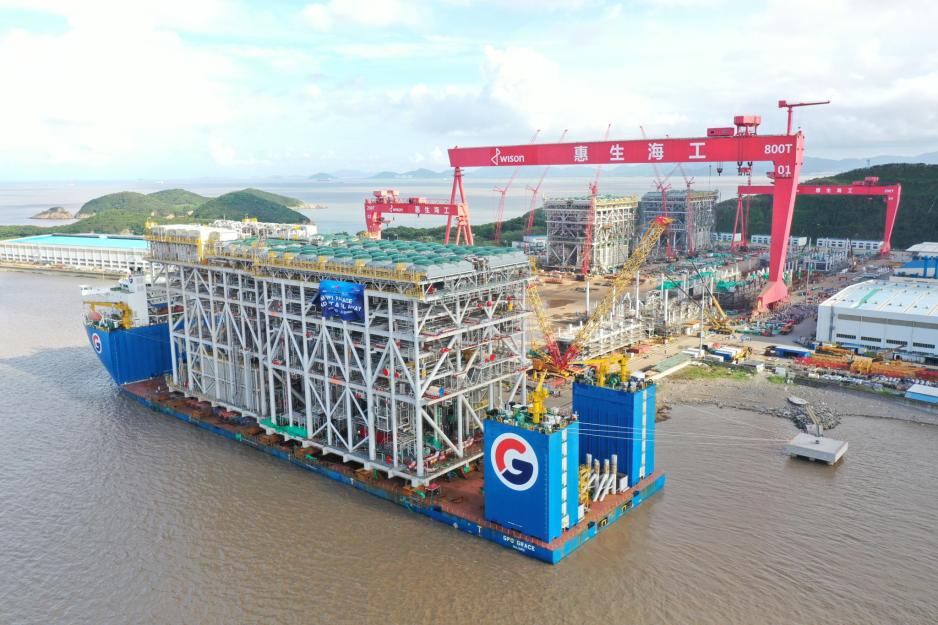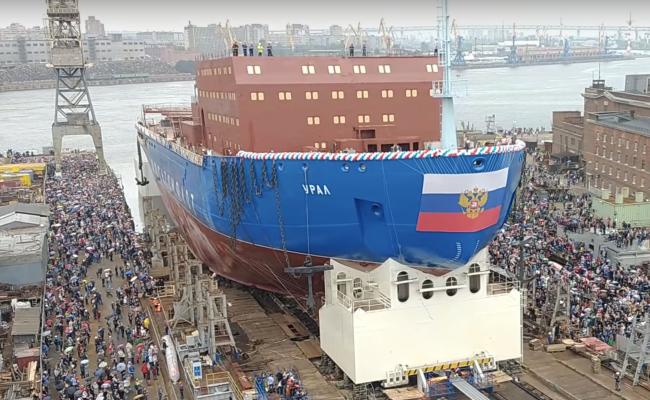China To Build New Heavy Icebreaker and Lift Vessel for Arctic

Model of a proposed Chinese heavy Polar Class icebreaker. (Source: Courtesy of the China Shipbuilding Industry Corporation)
In a policy note China lays out steps for a new heavy icebreaker, improved Arctic rescue capacity, and a semi-submersible heavy lift vessel. Officials call for design plans to be finalized within 3-5 years.
China’s Ministry of Transport released a policy note detailing plans for a new heavy icebreaker. The document also outlines the need for a 100,000-ton semi-submersible heavy lift vessel of the type used to deliver prefabricated modules to Russia’s liquefied natural gas (LNG) plants in the Arctic. Such a vessel would rival the world’s largest semi-submersible heavy lift ships in service today.
These vessels can be seen as integral to China’s latest five-year development plan released earlier this year, which calls for enhanced polar exploration through the use of specialized vessels including capable icebreakers and heavy lift vessels.
“[These plans] indicate that China still sees the Arctic as a policy priority, and wishes to continue to develop the Polar Silk Road despite many setbacks in the Nordic region, including with Greenland, as well as ongoing uncertainty over the post-pandemic economy,” explains Marc Lanteigne, professor and researcher in politics, security and international relations at the University of Tromsø.
“In addition to the heavy icebreaker, the heavy lift vehicle also suggests that Beijing is anticipating a considerable uptick in Chinese sea traffic, as well as increased demand for Russian fossil fuels, in the far north in the coming years.”
Greater Arctic Capacity
Currently China operates two conventionally-powered icebreakers; one homebuilt and one acquired from Ukraine, which was subsequently modified and refurbished. Naval security experts have in the past suggested that China is on the path to developing a nuclear-powered icebreaker potentially serving as a test bed for nuclear propulsion, which could then be deployed in the country’s next generation aircraft carriers.
The new Ministry document calls for greater coordination within the department to research the key technologies of heavy icebreakers and to strengthen Chinese emergency assistance capacity along the “Polar Silk Road.” A key aspect is the request to standardize and serialize the design of heavy icebreakers, hinting at the possibility that China intends to build several vessels of the same type following an approach long-practiced by Russia.
The Ministry expects results of this process within the next 1-2 years, at which time it wants preliminary research for the emergency rescue capacity along the NSR and the heavy icebreaker completed. Within 3-5 years it expects design plans for the icebreaker to be completed.
“These vessels will be used to underline China’s views that it wishes to be a development partner for the Arctic, as well as taking advantage of a perceived window of opportunity as the U.S. faces challenges trying to update its own icebreaker capability in the next decade,” elaborates Lanteigne.
The additional icebreaker will also allow China to conduct a multifaceted set of missions in Antarctica as well.
According to the policy document the emergency and rescue unit shall include special capacity to respond to spills of hazardous chemicals at sea resulting from e.g. a capsizing or damage from sea ice.
Plans for the semi-submersible follow a similar timeline with initial feasibility reports and basic plans completed within 1-2 years, and finalized technical designs completed within 3-5 years.

GPO Heavylift semi-submersible vessel transporting Arctic LNG 2 train modules from the Zhoushan yard in China to the Gydan peninsula in the Russian Arctic. (Source: Courtesy of GPO Heavylift)
New Arctic White Paper
The Arctic and Arctic shipping along the Northern Sea Route have featured more prominently in China’s ambitions since the country’s White Paper in 2018 and the Polar Silk Road concept announced later that year.
China highlighted its position as a “near-Arctic state,” a category the U.S. vehemently denies exists, and stated that it would further its Arctic engagement through infrastructure investments, commercial trial voyages, and scientific endeavors. The country also announced plans to place a satellite into Polar orbit to improve its ability to monitor sea ice conditions and track shipping traffic along Russia’s Northern Sea Route.
Researchers also expect China to publish a revised Arctic White Paper next year which will address changes to the political, security, and environmental situation in the region over the past 4 years.
“While China continues to stress its support for multilateral cooperation and science diplomacy in the Arctic, the Xi government, partially as a response to U.S. pushback, is less restrained about outlining its economic and strategic goals in the Arctic as well as closer regional relations with Moscow,” concludes Lanteigne.




